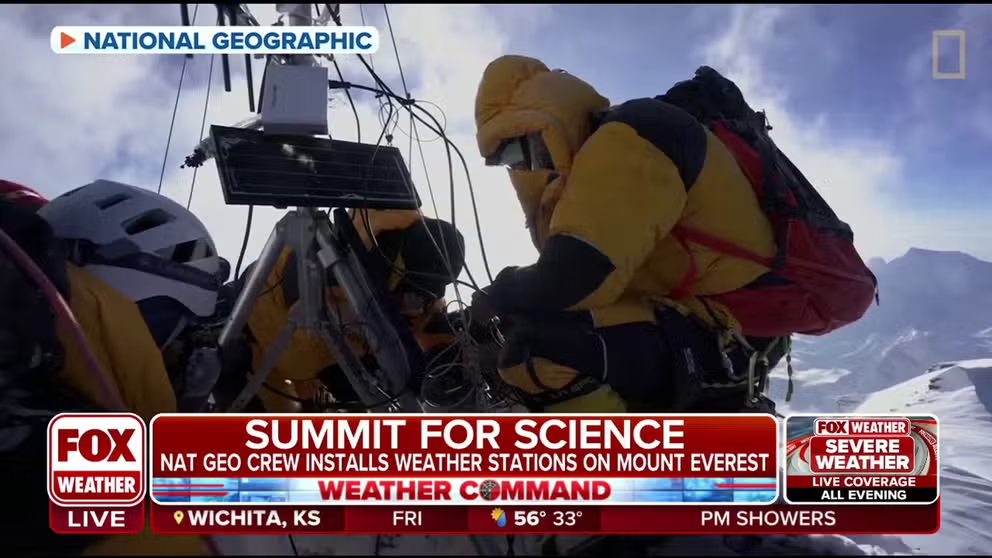Installing the world’s highest-altitude weather station on land: What it took to conquer Mount Everest
Scientists endured some of the harshest conditions the Earth has to offer to place weather instruments: deadly wind chills, cold temperatures, hurricane force winds and low oxygen. They also had to work around crowds. A climate scientist tells FOX Weather about the trials of the project and what scientists are learning.
National Geographic crew installs world's highest weather station on Mount Everest
National Geographic explorers faced extreme weather and record crowds as they struggled to install a crucial network of weather sensors. Tom Matthews, National Geographic explorer and climate scientist, discussed what it was like installing the world’s highest weather station on Mount Everest.
A group of scientists and Sherpa scaled Mount Everest, the highest point on Earth, to install weather stations – twice.
Tom Matthews, climate scientist and the co-lead for the National Geographic and Rolex Perpetual Planet Everest Expedition, trained and summited Mount Everest with both exhibitions. He joined FOX Weather's Weather Command and described some of the difficulties and explained why Everest needed weather stations.
In 2019, he, fellow scientists and Sherpa made history when they climbed almost five and a half miles above sea level and installed the highest-altitude weather station on land, according to Guinness World Records.
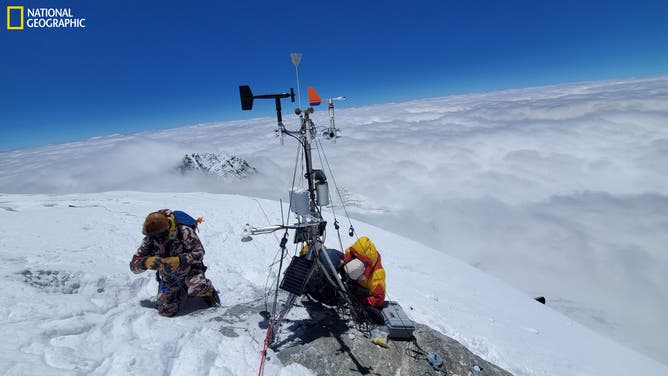
The team installing the Bishop Rock station.
(2022 National Geographic and Rolex Perpetual Planet Everest Expedition and Arbindra Khadka / FOX Weather)
But winter weather took a toll on the equipment and wiped out the highest station and damaged wind sensors at lower stations within a year. So he went again in 2022.
‘Strongest winds on Earth’
"These stations have to withstand some of the strongest winds on Earth. I mean, we're talking possibly up towards 100 meters per second, more than 200 miles an hour," Matthews told FOX Weather. "So we're talking really, really extreme conditions."
The summit can be in the subtropical jet stream. That jet varies in height between four and eight miles above sea level. The jet stream can reach speeds of more than 275 mph, the equivalent of an EF-5 tornado, according to the National Weather Service. A fast jet stream can cut time off commercial airline travel.
238-MPH JET STREAM SHAVES AN HOUR OFF CROSS-COUNTRY FLIGHTS TO EAST COAST
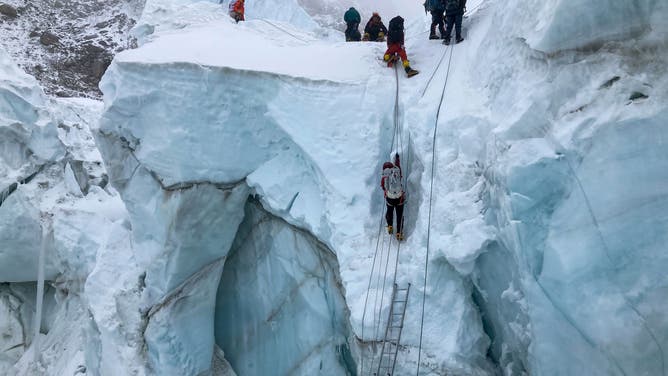
The expedition team navigates the Khumbu Icefall.
(2022 National Geographic and Rolex Perpetual Planet Everest Expedition and Baker Perry / FOX Weather)
Wind, cold and frostbite
And strong winds were not the only difficulty. He said the temperature while installing the highest station was only 68 degrees below zero. And 68 below zero was warmer than the 98 below zero that was expected.
Factor in the 45-mph winds, and the wind chill plunged to 104 below zero. Winds had to be 45 mph or lower for a safe ascent, he said, so the team had a small window.
Exposed skin can suffer frostbite in less than 10 minutes in these conditions. But installation took almost three hours, according to a paper that Matthews and the other scientists published in the Journal of the American Meteorological Society. They had planned for only two hours.
"And that cold, it does present a challenge," Matthews said. "It's very difficult to do the fine tasks that are required to assemble a weather station like this, for example, wiring in the different wires that connect the sensors to the computer, etc. So that cold really does present new challenges."
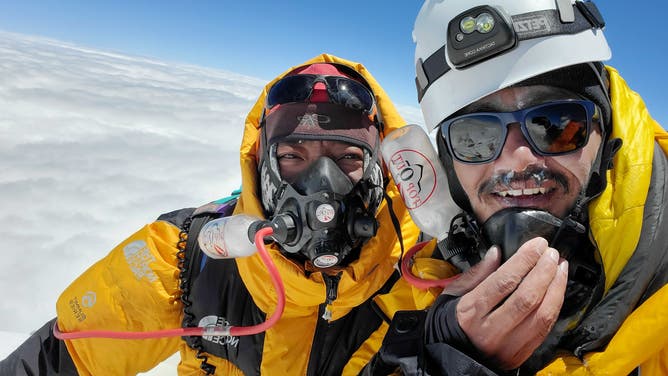
Climbers use oxygen because there is only a third of the amount of oxygen at the summit than at sea level. Sensors from the weather station have shown that oxygen varies day by day and with temperature on top of Everest.
(2022 National Geographic and Rolex Perpetual Planet Everest Expedition and Baker Perry / FOX Weather)
Matthews had to sit out part of the installation because he got frostbite. Matthew’s paper describes how the Sherpa worked without gloves completing the fine work without getting frostbite.
The group planned on installing the highest station, which is just 125 feet from the summit, on May 10. But wind forecasts for the day were getting stronger and stronger. Supplies at Camp 2, where the group rested, were running low, so they pushed their ascent up a day, the paper noted.

Climbers and tents at Camp III. The 2022 team was forced to climb from II to IIII because of incoming weather.
(2019 National Geographic and Rolex Perpetual Planet Everest Expedition and Baker Perry / FOX Weather)
That meant a rapid 4,900-foot climb straight to Camp 4. With high winds closing in, the scientists and Sherpa could only rest for a few hours before each lugging their extra 132 pounds of equipment up to Bishop Rock, the location of the highest station.
Matthews credits the Sherpa and their high-altitude mountaineering training with completing the installation despite the fatigue and cold, windy weather. The instruments were in place to measure the hurricane-force winds of 80 mph and the wind chill of 122 degrees below zero on May 10, their initial target. Exposed skin could get frostbite in just 2 minutes in those conditions.
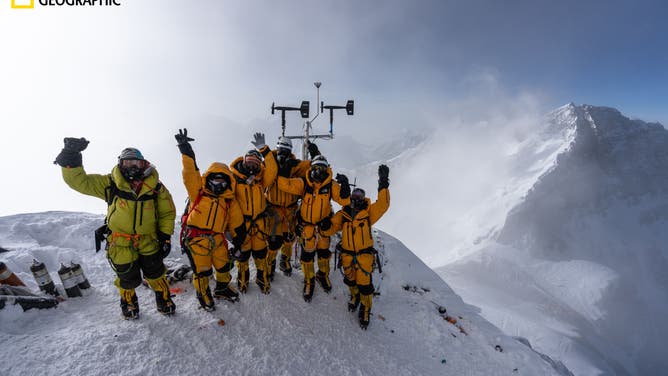
The team after installing the highest weather station in the world in 2019.
(2019 National Geographic and Rolex Perpetual Planet Everest Expedition and Mark Fisher / FOX Weather)
Matthews said that most of the almost 800 climbers that attempt Everest each year aim for spring, especially the second two weeks of May when the weather is most likely to cooperate. The National Geographic and Rolex Return to Everest Expedition team aimed for early May to avoid crowds.
The 2019 expedition faced record crowds near the summit. They had hoped to place the station at Bishop Rock but had to install it at Balcony, which is 1,433 feet below the summit. Because of the forecast for high winds, multiple climbing groups were forced to try to summit simultaneously, forcing the scientists to go with the lower location.
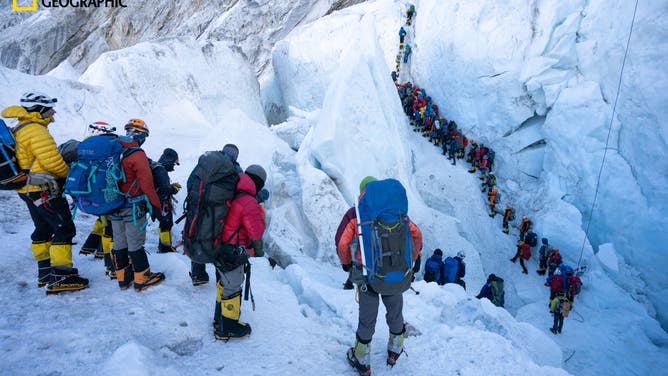
Crowds in 2019.
(2019 National Geographic and Rolex Perpetual Planet Everest Expedition and Eric Daft / FOX Weather)
Why does Mount Everest need weather stations?
"And why go to all this effort? Why put these precision-engineered custom weather stations up there, the tremendous effort and expense to do it?" Matthews said. "Dangerous weather is something to really worry about or be concerned with in the context of Everest, of mountaineering."
"Around a quarter of the deaths that have occurred on Mount Everest have been attributed, in some way, to bad weather or bad weather has played a role," he continued.
He points to the 1996 tragedies, which were documented by Everest, the IMAX film. A bestselling book, "Into Thin Air" also details the summit attempt in which eight people died. PBS’s NOVA presented "The Mystery of Mallory and Irvine 1924" about the two British mountaineers attempting to be the first to summit Everest but disappeared.
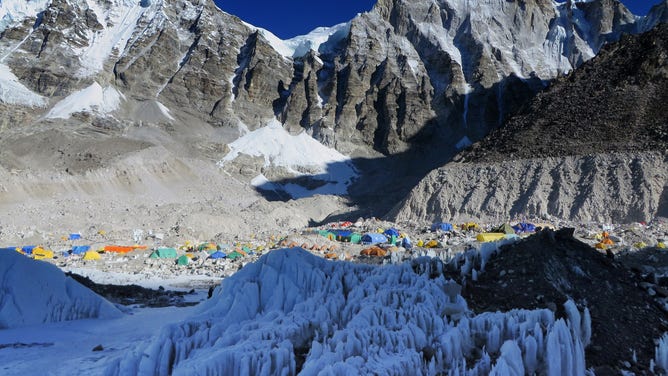
Everest Base Camp in 2014 after an avalanche killed 16 Sherpa.
(ROBERT KAY/AFP / Getty Images)
Edmund Hillary in 1953 was the first known mountaineer to summit the world’s tallest peak with his Sherpa.
With surface weather observations, meteorologists are finally able to prove the weather forecasts which climbers live and die by, Matthews said. That will improve the forecasts keeping Sherpa and climbers safer.
"And that whole network helps us better understand how the glaciers, the enormous stores of water and high-mountain nature and may respond to future climate warming and how they are responding to future climate and to current climate change, the change we've experienced to date," Matthews added.
ANTARCTICA'S ‘DOOMSDAY GLACIER’ IS MELTING AWAY DIFFERENTLY THAN SCIENTISTS FIRST THOUGHT
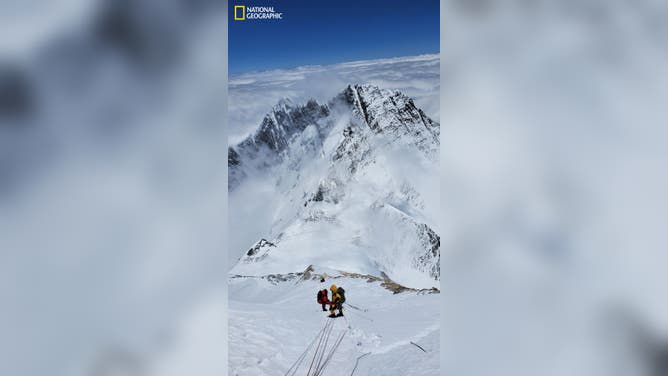
The 2022 Expedition.
(2022 National Geographic and Rolex Perpetual Planet Everest Expedition and Baker Perry / Getty Images)
He called the glacier at the peak "the Himalayan Water Tower." In his paper, he said better understanding the water cycle of the glacier will improve projections of future freshwater availability downstream. More than 1.6 billion people depend on that water source, according to Guinness World Records.
National Geographic has an Everest Weather Portal if you want to check out the weather conditions. You can also use the FOX Weather app to find the Mount Everest Base Camp forecast.
